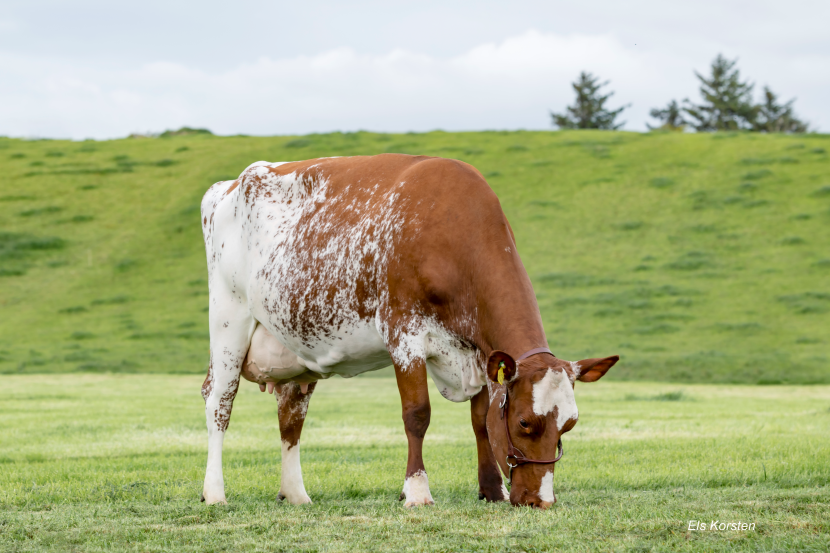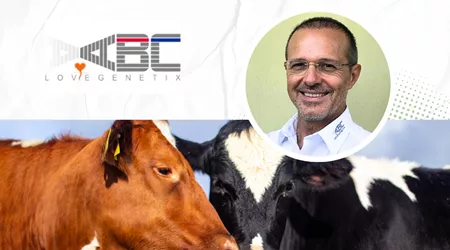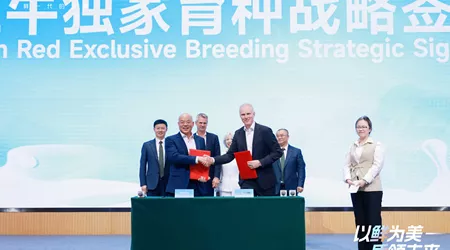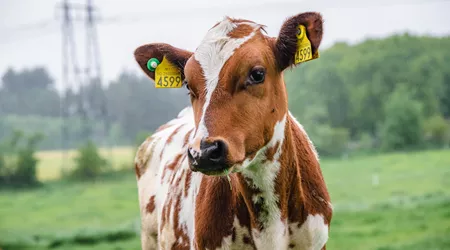By Gary Rogers
Inbreeding rates in Norwegian Red are much lower than in other important dairy populations.
The impact of inbreeding
It is widely known and accepted that inbreeding reduces health, fertility, and survival in all species including dairy cattle. However, these traits are not the only important traits impacted by inbreeding in dairy cattle. Estimates of inbreeding impact from December 2022 US Council on Dairy Cattle Breeding (CDCB) indicate that 10% inbreeding reduces lactation fat yield by 12 kg (27 pounds) and lactation protein yield by 10 kg (21 pounds) in the US. In essence, the total economic impact of mild to moderate inbreeding is substantial and represents and major opportunity cost for commercial dairy producers.
Inbreeding in Norwegian Red versus Holsteins and Jerseys
Inbreeding rates in Holstein and other important dairy populations are much higher than in Norwegian Red. See Figure 1 for the pedigree-based inbreeding trend in the Norwegian Red population. Note that inbreeding has only increased by 1.5% over the past 30 years in Norwegian Red. Also, recent rates of inbreeding are similar to the rates 20-30 years ago, even with the implementation of genomic selection in Norwegian Red. Inbreeding based on genomic data/genotypes is very similar to the pedigree-based inbreeding in Norwegian Red.

Inbreeding in Norwegian Red contrasts with inbreeding in the US Holstein and US Jersey cow populations illustrated in Figure 2 (December 2022 US CDCB). Figure 2 shows the development of inbreeding in the US cow populations since 1960 but the recent increases in inbreeding are significant.
The increasing trend in inbreeding is perhaps best illustrated in Figure 3 which is based on young genomic Holstein sires tested in the US. Inbreeding based on genotypes is slightly higher than what would be predicted from a pedigree in these young genomic sires, but the main point is that inbreeding is substantial in the genotyped young sires no matter which measure is used.


As a benchmark, the inbreeding in Holsteins and Jerseys can be compared with the expected inbreeding of 12.5% in offspring from mating half-siblings (for example, mating a cow and bull with the same sire) that are not inbred from other related ancestors. Mating of full siblings (animals with the same sire and dam) results in 25% inbreeding when sire and dam are not inbred due to prior generations.
Inbreeding in the US Holstein population is likely a strong indicator of inbreeding in most other Holstein populations as the exchange of Holsteins globally is well developed and Holstein breeding programs across the globe are somewhat similar.
The lower inbreeding in Norwegian Red compared to Holsteins is due to many reasons, however, the key difference is that the Norwegian Red breeding program has been designed to maintain a high level of genetic diversity even while undergoing intense selection and short generation intervals like other populations.
Some inbreeding in purebred populations is unavoidable
Genetic improvement in purebred populations is critical for improving the overall efficiency and sustainability of dairy production and the dairy industry will need to accept that some inbreeding in purebreds is unavoidable. Current rates of genetic improvement are at historical highs in most purebred populations. However, inbreeding significantly reduces the benefit of genetic improvement. Overall performance has improved despite increased inbreeding, but the inbreeding significantly reduces the benefit of increased genetic improvement.
Inbreeding is significant for dairy herds and populations that use purebreds for commercial production. Purebred mating programs can moderate inbreeding effects to some extent, but this becomes much more difficult in highly related purebreds. Maintaining separate lines can help with inbreeding as well but this too eventually ends with high levels of inbreeding unless lines are kept completely separate over time. In large herds, where sire assignment and individual cow mating programs cannot be easily used to minimize inbreeding, the resulting inbreeding will have a major impact on herd welfare and performance. It is these large herds that likely suffer the most from increased inbreeding if they rely on purebreds for their herds.
Good news
Fortunately, inbreeding depression is eliminated with crossbreeding. Crossbreeding doesn’t reduce the need for purebreds and intense breeding programs but crossbreeding allows producers to capitalize on the benefits of purebred breeding programs as well as capture the heterosis or hybrid vigor that results from crossbreeding. Crossbreeding eliminates all the inbreeding depression that occurs in purebreds no matter how high the level of inbreeding in the purebreds is. Crossbreeding is used very successfully in pig and poultry production as well as in many other agricultural enterprises and crossbreeding can be effectively used in dairy cattle.
Norwegian Red will play an important role in crossbreeding for commercial herds that are focused on efficient and sustainable dairy production.
Inbreeding in purebreds can be viewed as a positive if crossbreeding is used in commercial stocks as crossbreeding eliminates the impact of inbreeding even for the most inbred breeds or lines. Inbreeding can be used to accelerate genetic change in situations where purebreds are going to be crossed for commercial production so inbreeding in Holsteins, for example, is not a concern if Holsteins are used in a properly designed crossbreeding program at the herd level.
Norwegian Red will play an important role in crossbreeding for commercial herds that are focused on efficient and sustainable dairy production. Norwegian Red sires provide outstanding milk solids production and moderate cow size along with tremendous fertility and health when included in a crossbreeding program.
Take home messages
Norwegian Red has still low inbreeding.
Inbreeding in most dairy cattle populations has accelerated over the past 10-15 years and has reached alarming levels. Norwegian Red is an exception to this and still has low inbreeding.
Some inbreeding is a normal consequence of very intense selection and short generation intervals practiced by modern breeding programs. Consequently, inbreeding will continue to increase in purebred dairy populations.
Inbreeding substantially reduces the efficiency and sustainability of purebred dairy cattle and creates animal welfare concerns. As inbreeding continues to increase in purebreds, mating plans used to avoid mating-related individuals become less effective.
Crossbreeding can be used to eliminate the undesirable impact of inbreeding and well-designed crossbreeding programs should be utilized in commercial dairy herds to improve economic efficiency and sustainability.
Many more commercial dairy herds will adopt crossbreeding programs soon as these herds come to recognize the management, profitability, and sustainability benefits provided by a well-designed crossbreeding program.



